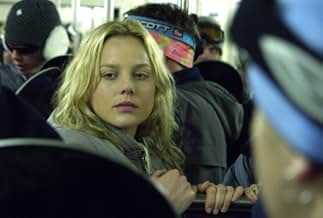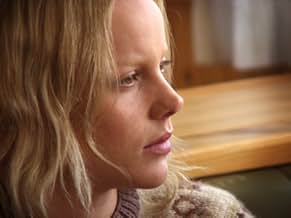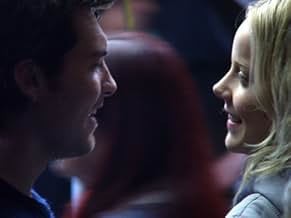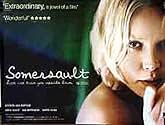IMDb RATING
6.7/10
8.4K
YOUR RATING
A young girl flees her hometown and arrives in the Australian Alps, where new experiences help her learn the differences between sex and love.A young girl flees her hometown and arrives in the Australian Alps, where new experiences help her learn the differences between sex and love.A young girl flees her hometown and arrives in the Australian Alps, where new experiences help her learn the differences between sex and love.
- Awards
- 41 wins & 15 nominations total
Anne-Louise Lambert
- Martha
- (as Anne Louise Lambert)
- Director
- Writer
- All cast & crew
- Production, box office & more at IMDbPro
Featured reviews
There is a moment in Cate Shortland's "Somersault" where Joe (Sam Worthington), a surly and emotionally closed-off young man confused over the feelings he has for his kind-of girlfriend Heidi (Abbie Cornish), shows up at the home of an openly gay acquaintance of his mother's andafter downing several shots and spilling his guts to the older manfollows him into the hallway and makes an awkward pass at him by planting a drunken kiss on him. It's a surprising twist in both Joe's development as a character and the movie itself, but it's just one of several similarly unexpected--and unexplained--moments that define Shortland's oddly compelling drama about sexual coming-of-age. Joe is not the main character, nor does the film ever revisit his attempt at same-sex experimentation, and it's that vague attention to detail that is the most frustrating aspect of the movie. The story actually belongs to Heidi, an evidently emotionally troubled teenager with no concept of propriety who, for no apparent reason, decides to make a pass at her mother's hunky boyfriend. When mom comes home and catches the two kissing, she freaks, and Heidi runs away to a neighboring town. There, she shacks up in the small flat of an empathetic motel owner, gets a job at the local BP service station, and has sex with a string of guys. It is Joe, however, that most captivates her, and their awkward and strained attempts at forging a relationship are some of the most authentic captured on celluloid. Both of them are plagued by troubles that are never explored (apparently, Heidi once tried to commit suicide, as is evidenced by the scars on her wrists), but as they begin to open up to each other, the movie becomes more fascinating and oddly romantic. Shortland's direction is as languid as her ambling script (a bit more back story on the characters would have made them more three- dimensional), but her style is effective nonetheless, providing a showcase for the talents of both Worthington and Cornish, two young Aussie up-and-comers who appear to have big futures ahead of them. Grade: B.--Originally published in IN Los Angeles Magazine.
I must confess some bias, being a massive fan of the Snowy area :) This film I can see not appealing to those who have never been to the Cooma/Jindabyne area of NSW. They will have no point of reference. For those who have however, this film is simply brilliant. I have stayed at the motel Heidi stayed at. I have visited friends with houses like Joes. The mood/feeling of Heidi around the edges of Lake Jindabyne are uncanny. There is a feeling down there I have not had anywhere else in Australia. A barren, cold feeling that is at once breathtaking and heartbreaking.
Objectively, one could indeed see this movie being light on concerning the plot. In my mind and experiences though, I have never been so engrossed. Heidi and Joes relationship is so tantalising. So possible. It might seem to some as not realistic, but it really is. This is how many, many Australians express themselves ( on a good day! ) It is pure, and wonderful, and simply amazing and I don't care that this may have been the only film close to warranting attention in 2004. It is regardless completely brilliant, and I for one will be holding it close to my heart for a long long time to come.
Australian cinema very rarely gets this close to actual emotion, and this film hits it again and again. Some of it may be contrived or stereotypical, but overall it really is a gem hidden amongst 21st century Australian cinema pap. Enjoy it please :)
Objectively, one could indeed see this movie being light on concerning the plot. In my mind and experiences though, I have never been so engrossed. Heidi and Joes relationship is so tantalising. So possible. It might seem to some as not realistic, but it really is. This is how many, many Australians express themselves ( on a good day! ) It is pure, and wonderful, and simply amazing and I don't care that this may have been the only film close to warranting attention in 2004. It is regardless completely brilliant, and I for one will be holding it close to my heart for a long long time to come.
Australian cinema very rarely gets this close to actual emotion, and this film hits it again and again. Some of it may be contrived or stereotypical, but overall it really is a gem hidden amongst 21st century Australian cinema pap. Enjoy it please :)
Somersault underlines a girl's desire of not wanting to be alone. The main character, Heidi, may appear to be flirtatious toward guys; yet what she wants is really to have a company. I guess her characteristics are derived from her mother, Nicole. Thus this is one interesting point of view to look at: about the parallelism of stories between the mother and the daughter. From the short appearance of Nicole, I believe she has her own story of not wanting to be alone. Else, where would Heidi come from? In terms of storyline, I see the simple third act form; beginning, middle, end. Heidi has a journey, and after all the troubles, she manages to resolve with her problems. Heidi's diary might help the audience to know Heidi's back-story. I like how clever the dialog between Heidi and her 'boyfriend' is constructed. In terms of technicalities, the use of landscape and natural elements helps the audience to engage with the story. The snow, the "tears" caused by using hot water to crack the snow on the car's windscreen, the red color
(I am not going to spoil the film here =) ). The mood of the film is very blue from the very beginning; we even see a blue laundry basket! When the resolution is made, though, the light brightens
very nice indeed. "It's good that we met", Somersault.
"Somersault" is a fresh spin on the in-over-their heads teenager movie, particularly the mixed-up city girl confusing the well-meaning country boy sub-genre. It is a sophisticated look at the motivations and resourcefulness of a teen age runaway.
In her debut feature, writer/director Cate Shortland poignantly captures a girl's search for love and independence through sex. It isn't often that we see a film about tantalizing jail-bait from the girl's perspective.
The town settings from Canberra to Jindabyne in New South Wales are unusual for Australian films we usually get to see in the U.S., providing an unusual meeting place for cold-weather tourists, the poor in their service industry, and farmers in from cattle stations.
Abbie Cornish is a marvel in the central role. Looking startlingly like the young Nicole Kidman from her early Australian movies such as "Flirting", she morphs from coltish girl to sexual aggressor, even as it's clear she doesn't understand what she's getting herself into by thinking she can live out her fantasy in following one guy after another who she has met on the road. With the glimpses we get of her tumultuous inner world through a childish diary, "Heidi"s naiveté is palpably painful as Cornish projects her at different times in the film as being the character's actual 16 or pretending to be 20 when she thinks she can use sex as a manipulable tool without realizing what creepy situations can result. The subtlety of her performance extends to how differently she relates to men than women, particularly as she keeps seeking out mother figures.
Sam Worthington is heartbreakingly sweet as equally naive, somewhat older "Joe", who clumsily becomes her protector and something more. I wasn't clear, though, about his back story with issues in his past (there's a lot of family secrets all around). The film also comments on bloke culture, including the ambiguous touches of homo-eroticism in male bonding.
The scenes between these two marginalized young people are engrossing with their attraction and hesitation, as they clumsily imitate adult behavior that they can't really handle. Bouncing between maturity and immaturity, tenderness and aggression, they have enough trouble expressing and understanding their feelings without adding sex into the mixture.
A side story with an autistic child leads to a way too didactic discussion about empathy and emotions, with flash cards no less.
The cinematography had a lovely blue haze, but used fuzzy focus too often.
I had some difficulty understanding the male dialogue among thick accents and low sound projection in the Time Square Theater, compounded by the restless male audience, up and down, in and out, slamming doors, who seemed mostly attracted to the film by Cornish's nude scenes.
This film is a creative contrast to American indie films that tend to see young women on the cusp of adulthood more as victims as they experiment with their sexual power, such as "Blue Car" or "Hard Candy", or in commercial fare as innocents, like "The Sisterhood of the Traveling Pants", let alone male fantasy objects as in "American Beauty". A spate of recent non-American directors have focused on their impact on males, such as in "The Holy Girl (La Niña santa)", "À Tout de Suite (Right Now)", and "Lila Says (Lila dit ça)", with varying degrees of the success of this film in capturing their girl/woman confusion.
In her debut feature, writer/director Cate Shortland poignantly captures a girl's search for love and independence through sex. It isn't often that we see a film about tantalizing jail-bait from the girl's perspective.
The town settings from Canberra to Jindabyne in New South Wales are unusual for Australian films we usually get to see in the U.S., providing an unusual meeting place for cold-weather tourists, the poor in their service industry, and farmers in from cattle stations.
Abbie Cornish is a marvel in the central role. Looking startlingly like the young Nicole Kidman from her early Australian movies such as "Flirting", she morphs from coltish girl to sexual aggressor, even as it's clear she doesn't understand what she's getting herself into by thinking she can live out her fantasy in following one guy after another who she has met on the road. With the glimpses we get of her tumultuous inner world through a childish diary, "Heidi"s naiveté is palpably painful as Cornish projects her at different times in the film as being the character's actual 16 or pretending to be 20 when she thinks she can use sex as a manipulable tool without realizing what creepy situations can result. The subtlety of her performance extends to how differently she relates to men than women, particularly as she keeps seeking out mother figures.
Sam Worthington is heartbreakingly sweet as equally naive, somewhat older "Joe", who clumsily becomes her protector and something more. I wasn't clear, though, about his back story with issues in his past (there's a lot of family secrets all around). The film also comments on bloke culture, including the ambiguous touches of homo-eroticism in male bonding.
The scenes between these two marginalized young people are engrossing with their attraction and hesitation, as they clumsily imitate adult behavior that they can't really handle. Bouncing between maturity and immaturity, tenderness and aggression, they have enough trouble expressing and understanding their feelings without adding sex into the mixture.
A side story with an autistic child leads to a way too didactic discussion about empathy and emotions, with flash cards no less.
The cinematography had a lovely blue haze, but used fuzzy focus too often.
I had some difficulty understanding the male dialogue among thick accents and low sound projection in the Time Square Theater, compounded by the restless male audience, up and down, in and out, slamming doors, who seemed mostly attracted to the film by Cornish's nude scenes.
This film is a creative contrast to American indie films that tend to see young women on the cusp of adulthood more as victims as they experiment with their sexual power, such as "Blue Car" or "Hard Candy", or in commercial fare as innocents, like "The Sisterhood of the Traveling Pants", let alone male fantasy objects as in "American Beauty". A spate of recent non-American directors have focused on their impact on males, such as in "The Holy Girl (La Niña santa)", "À Tout de Suite (Right Now)", and "Lila Says (Lila dit ça)", with varying degrees of the success of this film in capturing their girl/woman confusion.
Although slow to start I found I became increasingly involved in the story (young girl finding out what's appropriate in life and love) as the characters lives unfolded. By the end I was totally hooked. There might have been an attempt to show too many facets of the Australian character in this movie, but, in the end I didn't mind because the characterizations were so good. Rare to find in any movie. Was also nice to enjoy some good acting from unknown faces and excellent cinematography - the film had a great look - pale blue/white and red, and good editing. Don't be put off by the negative comments in other reviews, I know I shouldn't say this, but I think they've missed the point :)
Did you know
- TriviaTook 7 years to make.
- GoofsWhen Joe pours hot water onto the icy windscreen of his car, no steam appears.
- ConnectionsFeatured in Inside the Snowdome: Making 'Somersault' (2005)
- SoundtracksOnce Again
Written by Matt Walker
Performed by Matt Walker & The Necessary Few
Sony/ATV Music Publishing Australia
Licensed courtesy of Spaghetti Records
- How long is Somersault?Powered by Alexa
Details
- Release date
- Country of origin
- Official sites
- Language
- Also known as
- Tepetaklak
- Filming locations
- Production companies
- See more company credits at IMDbPro
Box office
- Gross US & Canada
- $92,214
- Opening weekend US & Canada
- $21,566
- Apr 23, 2006
- Gross worldwide
- $1,482,316
- Runtime
- 1h 46m(106 min)
- Sound mix
- Aspect ratio
- 1.85 : 1
Contribute to this page
Suggest an edit or add missing content


































